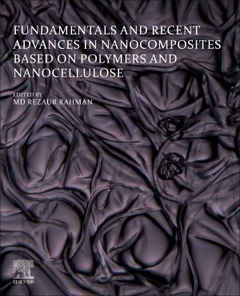Description
Fundamentals and Recent Advances in Nanocomposites Based on Polymers and Nanocellulose
Coordinator: Rahman Md Rezaur
Language: English
Subjects for Fundamentals and Recent Advances in Nanocomposites Based...:
Keywords
cellulose; nanocellulose; source; extraction; classification; linkages; structure; techniques; characterization; fabrication; properties; performance; processing; applications; reinforcement; aerogels; thermoplastic; thermoset; bioplastic; rubber; nanofiber; carbon fiber; foams; biomaterials; nanocomposite; bionanocomposite; biobased; composite; polymer; nanomaterials; biopolymer
312 p. · 19x23.4 cm · Paperback
Description
/li>Contents
/li>Biography
/li>Comment
/li>
Fundamentals and Recent Advances in Nanocomposites Based on Polymers and Nanocellulosebrings together the latest research in cellulose-based nanocomposites, covering fundamentals, processing, properties, performance, applications, and the state of the art.
The book begins by explaining the fundamentals of cellulose and cellulose-based nanocomposites, including sources, extraction, types, classification, linkages, model structure, model compounds, and characterization techniques. The second part of the book covers the incorporation of cellulose fillers to improve the properties or characteristics of nanocomposites, organized by composite category, including in aerogels, thermoplastic composites, thermoset composites, bioplastic composites, carbon nanofibers, rubber composites, carbon fibers, and foaming materials. Throughout these chapters, there is an emphasis on the latest innovations and application potential. Finally, applications are explored in more detail, notably focusing on the utilization of nanocellulose in biodegradable composites for biomedical applications, along with other important industrial application areas.
This book is of great interest to researchers, scientists, and advanced students working with bio-based materials, and across polymer science, nanomaterials, composite materials, plastics engineering, chemical engineering, materials science and engineering, as well as R&D professionals, engineers, and industrialists interested in the development of bio-based materials for advanced applications or material commercialization.
1. Sources of cellulose 2. Extraction, types, and classification of cellulose 3. Cellulose interunit linkages and model compounds 4. Advanced techniques for characterizing cellulose 5. Cellulose-based aerogels 6. Cellulose reinforcement in thermoplastic composites 7. Cellulose reinforcement in thermoset composites 8. Cellulose reinforcement in bioplastic composites 9. Cellulose-based composite carbon nanofibers 10. Cellulose-reinforced rubber composites 11. Cellulose-derived carbon fibers 12. Cellulose-based foaming materials 13. Utilization of nanocellulose as reinforcement in biodegradable biomaterials 14. Applications of cellulose materials and their composites
- Presents the fundamentals of cellulose-based nanocomposites, including sources, extraction, types, classification, linkages, structure, compounds, and characterization.
- Discusses and analyzes the most suitable fabrication methods and processing techniques for cellulose as a reinforcement in a range of composites.
- Opens the door to a range of cutting-edge applications and considers key aspects such as cost, lifecycle, and biodegradability.




